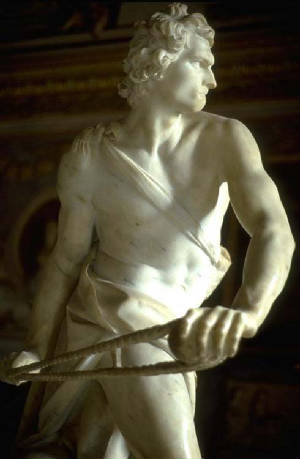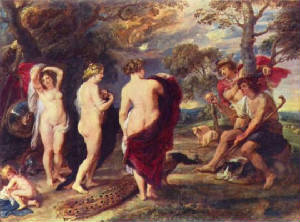 

|
baroque baroqueberōk´, in art and architecture, a style developed
in Europe, England, and the Americas during the 17th and early 18th cent. The baroque style is characterized by an emphasis
on unity among the arts. With technical brilliance, the baroque artist achieved a remarkable harmony wherein painting, sculpture,
and ar...
Baroque period, era in the history of the Western arts roughly coinciding
with the 17th century. Its earliest manifestations, which occurred in Italy, date from the latter decades of the 16th century,
while in some regions, notably Germany and colonial South America, certain of its culminating achievements did not occur until
the 18th century. The work that distinguishes the Baroque period is stylistically complex, even contradictory. In general,
however, the desire to evoke emotional states by appealing to the senses, often in dramatic ways, underlies its manifestations.
Some of the qualities most frequently associated with the Baroque are grandeur, sensuous richness, drama, vitality, movement,
tension, emotional exuberance, and a tendency to blur distinctions between the various arts.
baroque -> Baroque Architecture Buildings of the period are composed
of great curving forms with undulating facades, ground plans of unprecedented size and complexity, and domes of various shapes,
as in the churches of Francesco Borromini, Guarino Guarini, and Balthasar Neumann. Many works of baroque architecture were
executed on a colossal scale, in...
Buildings of the period are composed of great
curving forms with undulating facades, ground plans of unprecedented size and complexity, and domes of various shapes, as
in the churches of Francesco Borromini, Guarino Guarini, and Balthasar Neumann. Many works of baroque architecture were executed
on a colossal scale, incorporating aspects of urban planning and landscape architecture. This is most clearly seen in Bernini's
elliptical piazza in front of St. Peter's in Rome, or in the gardens, fountains, and palace at Versailles, designed by Louis
Le Vau, Jules Hardouin-Mansart, and André Le Nôtre.
Related: European Art
|
|
baroque -> Baroque Painting Painters and sculptors built and expanded on the naturalistic
tradition reestablished during the Renaissance. Although religious painting, history painting, allegories, and portraits were
still considered the most noble subjects, landscapes, still lifes, and genre scenes were painted by such artists as Claude
Lorrain, ...
Painters and sculptors built and expanded on
the naturalistic tradition reestablished during the Renaissance. Although religious painting, history painting, allegories,
and portraits were still considered the most noble subjects, landscapes, still lifes, and genre scenes were painted by such
artists as Claude Lorrain, Jacob van Ruisdael, Willem Kalf, and Jan Vermeer. Caravaggio and his early followers were especially
significant for their naturalistic treatment of unidealized, ordinary people. The illusionistic effects of deep space interested
many painters, including Il Guercino and Andrea Pozzo. Other baroque painters opened up interior spaces by representing long
files of rooms, often with extended views through doors, windows, or mirrors, as in the works of Diego Velázquez and Vermeer.
Color was manipulated for its emotional effects,
ranging from the clear calm tones of Nicholas Poussin, to the warm and shimmering colors of Pietro da Cortona, to the more
vivid hues of Peter Paul Rubens. A heightened sense of drama was achieved through chiaroscuro in the works of Caravaggio and Rembrandt. Carracci and Poussin portrayed
restrained feeling in accordance with the academic principles of dignity and decorum. Others, including Caravaggio, Rubens,
and Rembrandt depicted religious ecstasy, physical sensuality, or individual psychology in their paintings.
BAROQUE SCUPTURE
Baroque sculptors felt free to combine different
materials within a single work and often used one material to simulate another. One of the great masterpieces of baroque sculpture,
Giovanni Bernini's St. Theresa from the Cornaro Chapel, for example, succumbs to an ecstatic vision on a dull-finished marble
cloud in an alabaster and marble niche in which bronze rays descend from a hidden source of light. Many works of Baroque sculpture
are set within elaborate architectural settings, and they often seem to be spilling out of their assigned niches or floating
upward toward heaven.
|
Resulting in part from the libertarian and egalitarian
ideals of the French Revolution, the romantic movements had in common only a revolt against the prescribed rules of classicism . The basic aims of romanticism were various: a return to nature and
to belief in the goodness of humanity; the rediscovery of the artist as a supremely individual creator; the development of
nationalistic pride; and the exaltation of the senses and emotions over reason and intellect. In addition, romanticism was
a philosophical revolt against rationalism .
In the visual arts romanticism is used
to refer loosely to a trend that appears at any time, and specifically to the art of the early 19th cent. Nineteenth-century
romanticism was characterized by the avoidance of classical forms and rules, emphasis on the emotional and spiritual, representation
of the unattainable ideal, nostalgia for the grace of past ages, and a predilection for exotic themes.
Romantic artists developed precise techniques in order to produce specific associations in the mind of the viewer. To convey
verbal concepts they would, for example, endow inanimate objects with human values (e.g., the wild trees and shimmery moonlight
used in the paintings of Caspar David Friedrich to suggest an infinity of human longing, the weltschmerz of his time).
The result was often sentimental or ludicrous. In the case of Delacroix , however, his painterly style and color sense exalted the romantic
attitude in a singularly effective fashion.
In England landscape gardening was used to express
the romantic aesthetic by means of deliberate imitation of the picturesque in nature. In architecture Wyatt 's preposterous, mock medieval Fonthill Abbey
displayed the romantic building style in extreme form. The host of lesser artists of the romantic tradition included the French
Géricault , the Swiss-English Henry Fuseli , the Swiss Arnold Böcklin , the English Pre-Raphaelites , the German Nazarenes , and the American artists of the Hudson River school .
Section: Romanticism in Music
Related: General Literature
Romanticism in music was characterized by an emphasis on emotion and great freedom of form. It attained
its fullest development in the works of German composers. Although elements of romanticism are present in the music of Beethoven , Weber , and Schubert , it reached its zenith in the works of Berlioz , Mendelssohn , Schumann , Chopin , Liszt , and Wagner . Less totally romantic composers usually placed in the middle period
of romanticism are Brahms , Tchaikovsky , Dvořák , and Grieg ; those grouped in the last phase include Elgar , Puccini , Mahler , Richard Strauss , and Sibelius .
| in art, the movement of the mid-19th cent. formed in
reaction against the severely academic production of the French school. Realist painters sought to portray what they saw without
idealizing it, choosing their subjects from the commonplaces of everyday life. Major realists included Gustave Courbet , J. F. Millet , and Honoré Daumier . In a broader sense the term is applied to an unembellished rendering
of natural forms. In recent years realism has come to mean the presentation of forms and materials that are simply themselves,
not primarily representations of things that already exist. |
realism 
Related: General Literature
|
in literature, an approach that attempts to describe life without
idealization or romantic subjectivity. Although realism is not limited to any one century or group of writers, it is most
often associated with the literary movement in 19th-century France, specifically with the French novelists Flaubert and Balzac.
George Eliot introduced realism into England, and William Dean Howells introduced it into the United States. Realism has been
chiefly concerned with the commonplaces of everyday life among the middle and lower classes, where character is a product
of social factors and environment is the integral element in the dramatic complications (see naturalism ). In the drama, realism is most closely associated with Ibsen's social
plays. Later writers felt that realism laid too much emphasis on external reality. Many, notably Henry James, turned to a
psychological realism that closely examined the complex workings of the mind (see stream of consciousness ).
realism 
Related: Philosophy
in philosophy. 1 In medieval philosophy realism
represented a position taken on the problem of universals . There were two schools of realism. Extreme realism, represented by
William of Champeaux , held that universals exist independently of both the human mind and
particular things—a theory closely associated with that of Plato. Some other philosophers rejected this view for what
can be termed moderate realism, which held that universals exist only in the mind of God, as patterns by which he creates
particular things. St. Thomas Aquinas and John of Salisbury were proponents of moderate realism. 2 In epistemology realism
represents the theory that particular things exist independently of our perception. This position is in direct contrast to
the theory of idealism, which holds that reality exists only in the mind. Most contemporary British and American philosophy
tends toward realism. Prominent modern realists have included Bertrand Russell, G. E. Moore, and C. D. Broad.
| |
|

